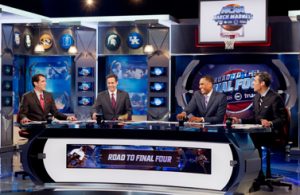Do you ever wonder why you only hear male announcers during Men’s March Madness games?
It’s because for as long as March Madness has been around, only two women have ever been hired as sports analysts. According to a New York Times article, Debbie Antonelli was hired as the first woman since 1995 to be an analyst in the 2017 N.C.A.A men’s tournament games. Debbie Antonelli has been a sideline reporter for 29 years, studying hundreds of teams and players. There are plenty of women qualified to call men’s tournament games. But it took twenty two years for another woman to have an opportunity to work on a men’s tournament broadcast. Debbie Antonelli knows that a lot of pressure rides on her performance, because if she makes a mistake people will say, “Oh it’s because she is a woman.”
If women are just as qualified as men to broadcast, then why have there only been two women calling March Madness games in history?
Gender roles are a big factor. Gender roles are expectations for male and female behavior. In society, men are expected to be better at sports, therefore better at announcing them. Previous studies show that men tend to be more outspoken, confident, athletic and dominant. All these traits make a good sports broadcaster. But other studies show that people perceive women to be shy, quiet, and less sports oriented. Since society has such strong views on males and females, it’s no wonder the sports broadcasting industry is overfilled with males. Gender roles make males the perfect candidates for this job and make people question if females would qualify for such a position. Expectations for gender roles are real, but are not applicable to every individual. Not all girls are quiet and uninterested in sports. Many girls play college basketball, study the March Madness games and have worked in the men’s basketball field for years. Just because gender roles depict girls one way does not mean every girl has those characteristics. Women can be just as confident and knowledgeable about basketball as men.
According to a study done on Sex Segregation in Television Sports Broadcasting, women work mainly on sideline reporting, but are underrepresented as studio analysts and live announcers. This study focuses on the relationship between job classification within sports broadcasting and explanatory variables such as sex. Ninety Five percent of play-by-play announcers are male and 93 percent of sports analysts are males. Gender is a big factor in job distribution. Women are concentrated in lower sideline jobs, while males occupy higher positions. In society gender roles associate women to be less qualified as sports announcers than men because of their expected behaviors. The New York Times article shows how gender roles can be challenged. Debbie Antonelli has been working with college basketball for years, but it took the broadcasting industry two decades to finally hire her as a play-by-play announcer. Gender roles play a big role in Sports Broadcasting, but powerful women like Debbie Antonelli and enlightening news articles challenge the expected behaviors of women and men.
References
Macur, J. (2017, March 10). Another Woman at the March Madness Mike? That Only Took 2 Decades. The New York Times. Retrieved from https://www.nytimes.com/2017/03/10/sports/ncaabasketball/another-woman-at-the-march-madness-mike-that-only-took-2-decades.html?rref=collection%2Ftimestopic%2FESPN&action=click&contentCollection=business®ion=stream&module=stream_unit&version=latest&contentPlacement=2&pgtype=collection
Coventry, B.T. (2004). On the Sidelines: Sex and Racial Segregation in Television Sports Broadcasting. Sociology of Sport Journal, 21(3), 322-341. Retrieved from http://web.b.ebscohost.com/ehost/pdfviewer/pdfviewer?vid=2&sid=511b6c1c-df33-4909-8ab2-26c6a0536da9%40sessionmgr101&hid=101
Myers, D. (2015). Exploring Social Psychology. New York, NY: McGraw-Hill Education


